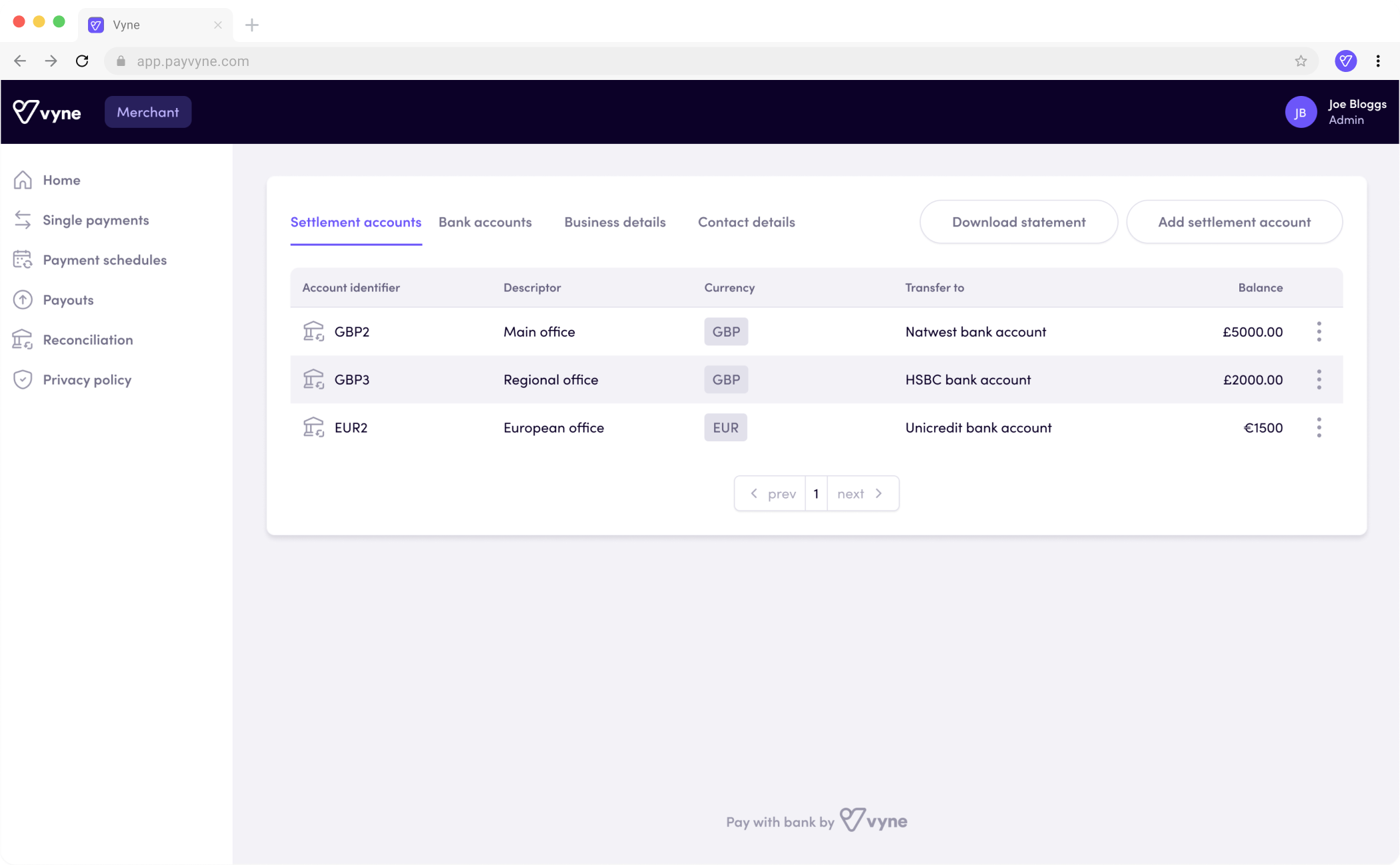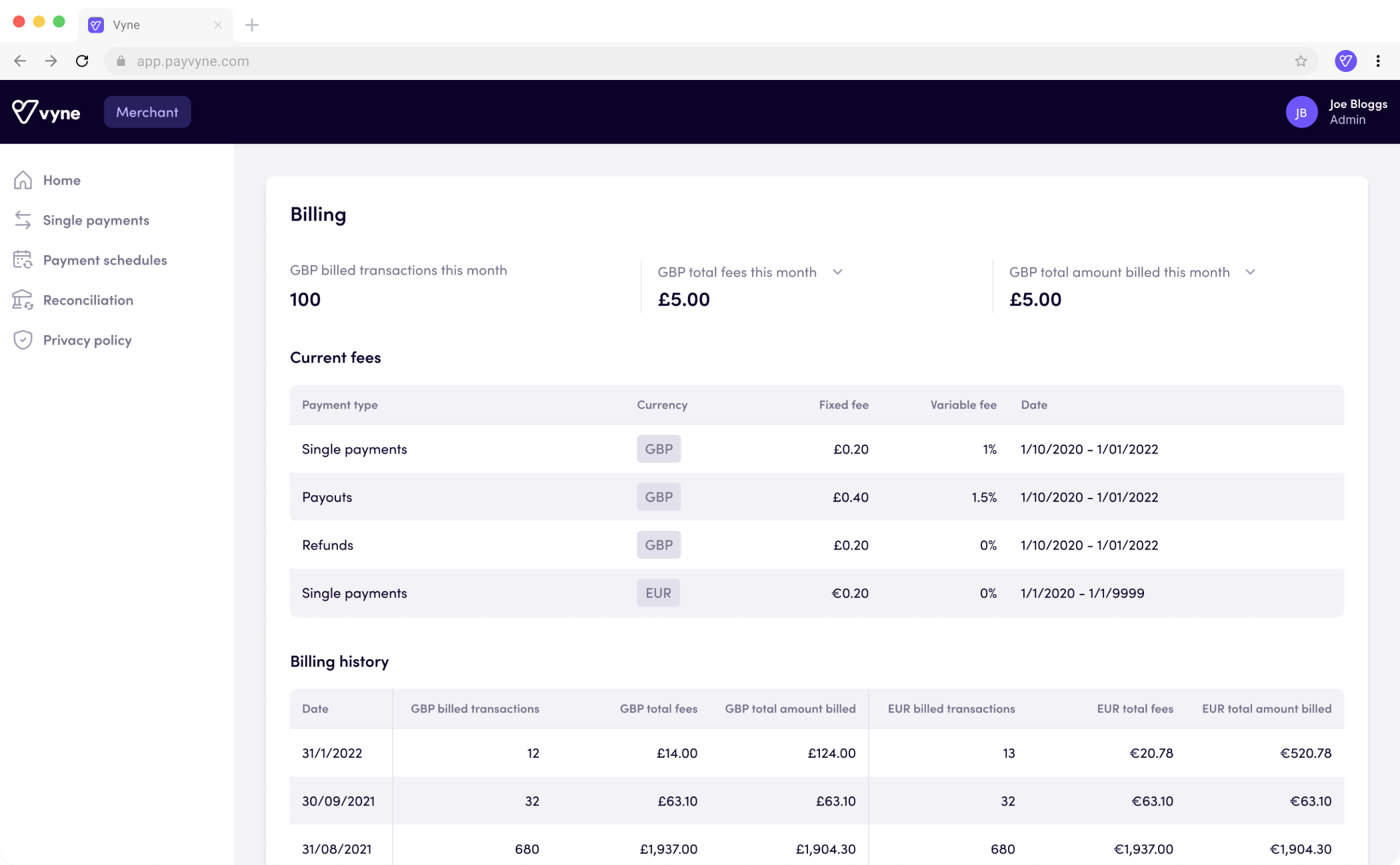Settlement
Reconciling thousands of payments on a daily basis can be a hassle, so we use different account types to simplify and control the flow of funds.
Account types

When a payment is made, funds are received into a settlement account attached to your Merchant account. A settlement account is an e-money account held in your name which is set up and managed by Vyne.
Settlement accounts sit alongside your destination account - this is your business or corporate account into which you want funds settled. We use settlement accounts to handle the flow of funds including payments, refunds, payouts, and fees. As well as providing an itemised history of each transaction type, you can also use a settlement account statement or reconciliation export to understand the flows of funds in and out of your account.
Sweeps (transfers/batch settlement)
Every 24 hours, the net funds from your settlement account are transferred to your destination account to reset your settlement account balance. Learn more about how to set up and use a settlement account here.
Reserve amount
During regular operations, your settlement account balance will be credited by payments, and debited by refunds, payouts, or fees. Settlement accounts do not have an overdraft or credit facility and any requests for debits that exceed the account balance will be rejected or fail. In order to ensure that you can continue to request refunds and payouts after a settlement account sweep has occurred it may be necessary to use a reserve amount.
A reserve amount can be used to define the balance of the account after all other funds have been transferred during the sweep. Using a reserve amount can ensure that the account balance does not zero after the sweep.
Try it out
We recommend setting the reserve amount to your average daily total refund and payout amount. Lean more about how to set a reserve amount here.
Top-ups
Sometimes it may be necessary to top-up your settlement account if the balance falls too low to process a refund or payout. You can top-up a settlement account by making a transfer from any of your pre-approved destination bank accounts.
You can view your existing destination accounts on the Accounts page in the Merchant portal. You can request addition of a new destination account here.
Try it out
Regular top-ups may be an indication that your reserve amount is set too low. Consider increasing the reserve amount on your settlement account.
Direct transfers
Settlement accounts operate like normal bank accounts with an account number & sort code or IBAN and these details are exchanged through the banking system with your payer's bank every time a payment is made. Sometimes consumers may be able to see these details and choose to make a direct manual bank transfer to your settlement account.
Not only do direct transfers cause additional noise in your settlement account, they can also be a customer service challenge. Regardless of whether these are totally unexplained or related to a payment requested separately through Vyne, direct transfers cannot be accepted for a Vyne payment as they lack required data.
For this reason, any direct transfers to your settlement account that don't originate from one of your pre-approved destination accounts will be automatically returned to the sender as soon as received. The total amount of the transfer will be credited back to the account it was sent from. Transfers that originate from a destination account are classified as top-ups (above).
Be aware
If the same direct transfer is attempted five times within a 24 hour period, the fifth transfer will no longer be returned and the amount will be credited to your settlement account balance.
Billing

Depending on the configuration of your account, you may be using monthly billing or net settlement billing.
If you're on monthly billing, we will charge an account of your choosing your total monthly fees using Direct Debit. You'll receive an invoice by email from our accounts team around the start of the following month. You won't be able to see individual transaction fees within the Merchant portal.
If you're on net settlement billing, fees will be deducted at the point of taking payment. A breakdown of your fees can be found in the Billing page in the Merchant portal and you'll be able to track the total amount billed for the current and previous calendar months. You'll also see fees displayed against single payments and refunds in some Merchant portal pages and reports.
Helpful to know
For monthly billing queries, contact our accounts team, or for queries with net settlement billing, contact our support team.
Updated almost 2 years ago
